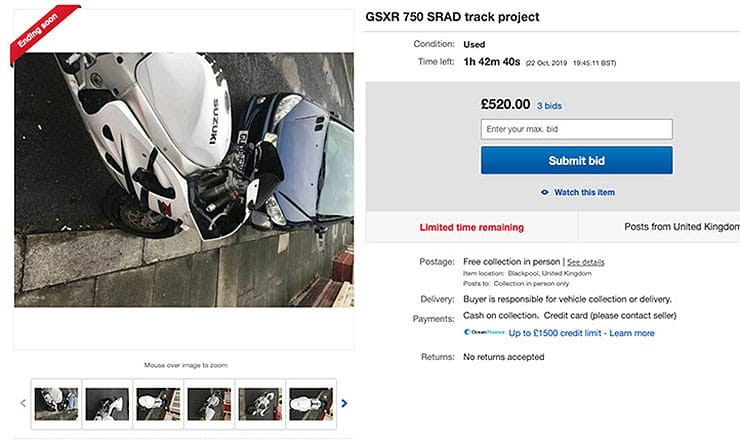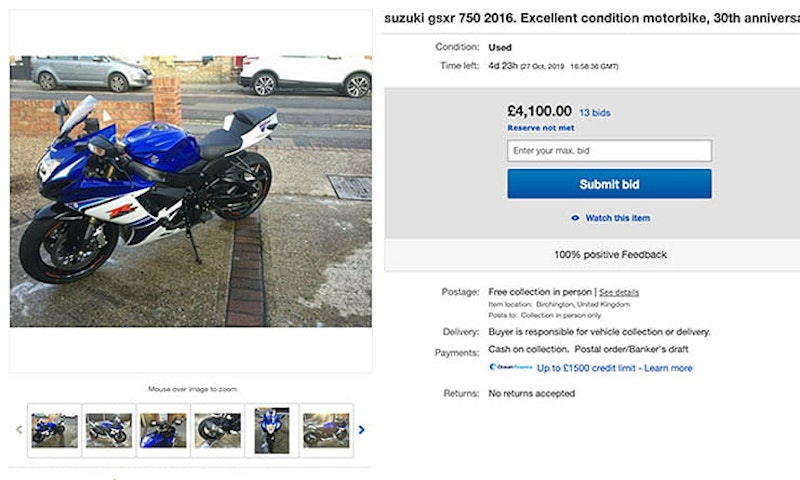Ebay is a huge marketplace for bikes, and can be a quick, easy and safe way to sell. But you need to apply a few principles to get a decent price and avoid being swamped by cretins or scammers. Here’s what to do.
Oh dear. Bike the wrong way up, not all of it in shot and little detail in the description
1. Don’t bother selling a bike on eBay unless you’ve got a positive feedback score of at least 10 – ideally more. If you haven’t, lots of potential buyers will dismiss you as flakey or a con artist, so you’d be better off selling on MCN or Biketrader. These sites can be more expensive and are not as big, but attract plenty of serious buyers.
2. Work out what the going rate is for your bike. Don’t just look at what price other sellers have got their bikes up for – those are useful to get a feel for the market, but obviously most won’t sell for those prices because buyers will haggle (or they won’t sell at all). If you click the ‘watch’ button on eBay for bikes that are being auctioned, and wait for the auction to end, you can then go to your ‘Watchlist’ and see what they actually made. This can help set a realistic price for your bike, though you may find not many bikes like yours are auctioned (see 3).
Not bad. Photo is ok (shooting lower would have given us more bike and less wall and cars). Doesn’t need to say it’s a motorbike
3. Sell it as a classified ad. Though eBay is an auction site, the vast majority of bikes over £2000 are sold as classifieds because it’s cheaper and lower stress. It costs a flat £19.99 to get a classified ad for a month, whereas an auction will cost you £11.99 plus 1% of the final value (min £25, max £45). So if you sell your bike for anything over £4500, the fees are a comparatively salty £56.99. Auctions are good if you’re in a rush or have a rare bike that you think will attract a bidding war though.
4. Take a decent main shot. This is crucial, as it appears as a thumbnail when people search. If this is out of focus, gloomy, doesn’t show all the bike, or is upsidedown (oh yes, people do it), loads of buyers will move on to the sparkly bike below it. A phone shot will work fine, but make sure you’ve got the sun behind you, it’s in focus, all the bike is in the frame and ideally there’s not too much clutter in the background. Ride out to a deserted car park if necessary. A front three-quarter angle works best (so buyers get to see the front and side).
Great main shot, and loads of others too. Could have given us more detail in the description though
5. Take loads of pics of a proper size. Ebay allows 12 shots for your £11.99, so use them all. Make sure you’ve got both sides, front and rear, clocks and a group shot of all your documentation (old MoTs, receipts, service book, second keys etc – though see 6, 7). The other shots can be close-ups – show the tyre wear, any dings or scratches, valuable aftermarket kit, and any spares that come with the bike. Try and show any faults that a buyer is bound to notice if they view the bike. It’ll help you come across as honest.
6. Obscure the registration plate and registration details in the documentation, either by using photo-editing software or hanging a tea towel over the plate. Toerags have been known to use eBay to clone bikes – they’ll search for a model identical to the one they’ve got (or stolen) that’s at the other end of the country, then get a plate made up for their bike. The first you know about it is when the speeding tickets start arriving, or the coppers turn up politely asking why you robbed a post office.
When you’ve done your ad, there’s a ‘preview’ button at the bottom. Use this to prevent vertical and upsidedown motorcycles
7. Obscure your address in the documentation photo. That’s just making it too easy for thieves.
8. Make good use of the main description line. You’ve got 80 characters, so why write “Suzuki GSXR”, when you could put “Suzuki GSX-R750 K5, full service history, two owners, 22,500 miles, A1 condition”?
Plenty of details, mentions the scrapes, and gives a bit of personal info. OK, so the spelling’s a bit patchy, but the owner seems genuine
9. Put as much detail as possible in the description (there’s no limit). Go through all the good points first – service history, how much you’ve spent, new tyres/chain, valuable aftermarket kit, alarm etc. Then explain why you’re selling. Being personal is good – people selling stolen bikes don’t often go to the trouble of explaining they’ve got dodgy knees and are moving on to an adventure bike, so the more real you sound, the more reassuring it is for buyers. Then list the obvious faults. Scratches and dings are the most common subjects. If there’s a horrible noise coming from the bottom end, we’d recommend you mention that too, rather than hope some poor fellow motorcyclist doesn’t notice. It depends on what your conscience can take, and how many hacked-off viewers you can tolerate.
10. Be direct with chancers. The main downside of Ebay for most sellers is that it attracts berks who think you’re going to sell for way less than your list price. If an offer is laughably low, be firm – even if it’s the only call you’ve had. If the bike is fairly priced, you’ll sell it for the right money eventually.
Nice substation. Ebay provides a cropping tool which could have remedied this
11. Take the usual selling precautions. The rest of the eBay selling process is just like selling privately through any other medium, so the usual rules apply: no test rides unless there’s cash in your hand, make sure money has cleared if it’s a bank transfer, don’t show them what else is in your garage, take a picture of them if you think they’re dodgy and don’t leave them alone with the bike.
12. Don’t panic! Despite #11, remember that the vast majority of buyers are fellow motorcyclists looking for a fair deal and are probably just as nervous of the process as your are.
Share on social media:

